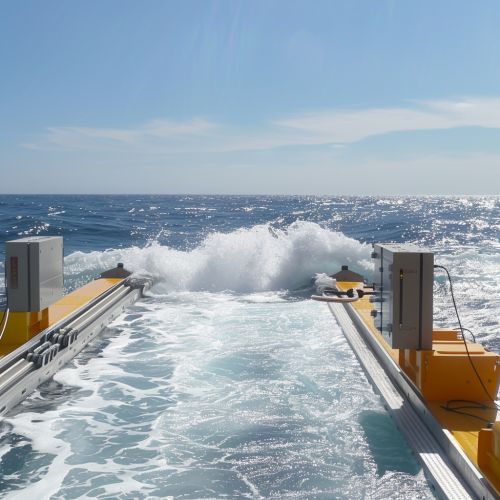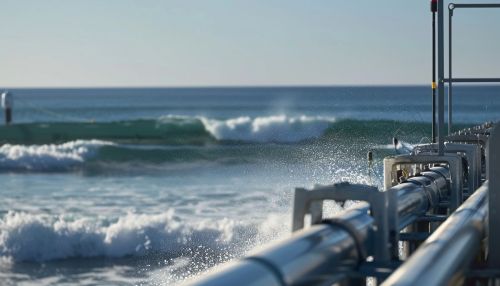Ocean Energy Conversion
Introduction
Ocean energy conversion refers to the process of harnessing the energy from oceanic sources to generate electricity or other forms of usable power. This energy can be derived from various oceanic phenomena such as tidal movements, wave action, thermal gradients, and salinity gradients. The vastness of the oceans and their dynamic nature make them a significant potential source of renewable energy. This article delves into the various methods of ocean energy conversion, their principles, technologies, and the challenges associated with their implementation.
Types of Ocean Energy
Tidal Energy
Tidal energy harnesses the gravitational pull of the moon and the sun, which causes the rise and fall of sea levels. This energy can be captured using tidal stream generators or tidal barrages.
Tidal Stream Generators
Tidal stream generators operate similarly to underwater wind turbines. They are placed in areas with high tidal flow, such as narrow straits or inlets. The kinetic energy of moving water drives the turbines, which in turn generate electricity. These generators are advantageous due to their predictability and minimal environmental impact.
Tidal Barrages
Tidal barrages are large structures built across estuaries or bays. They capture the potential energy of the difference in height (head) between high and low tides. Water flows through turbines in the barrage, generating electricity. While effective, tidal barrages can have significant ecological impacts on estuarine environments.
Wave Energy
Wave energy conversion captures the energy from surface waves. This method is highly variable and depends on the wave height, speed, wavelength, and water density.
Point Absorbers
Point absorbers are floating structures that move with the waves. They convert the vertical motion of waves into mechanical energy, which is then converted into electricity. These devices are typically anchored to the seabed and can operate in deep water.
Oscillating Water Columns
Oscillating water columns use the motion of waves to compress air within a chamber. The compressed air drives a turbine, generating electricity. These systems can be installed onshore or offshore and are relatively simple in design.
Ocean Thermal Energy Conversion (OTEC)
OTEC utilizes the temperature difference between the warm surface water and the cold deep water to generate electricity. This method is particularly effective in tropical regions where the temperature gradient is significant.
Closed-Cycle OTEC
In closed-cycle OTEC, a working fluid with a low boiling point, such as ammonia, is vaporized by warm surface water. The vapor drives a turbine, generating electricity. The vapor is then condensed by cold deep water and recirculated.
Open-Cycle OTEC
Open-cycle OTEC uses seawater as the working fluid. Warm surface water is evaporated in a low-pressure chamber, and the resulting steam drives a turbine. The steam is then condensed using cold deep water, producing desalinated water as a byproduct.
Salinity Gradient Energy
Salinity gradient energy, also known as blue energy, exploits the difference in salt concentration between seawater and freshwater. This energy can be harnessed using pressure retarded osmosis (PRO) or reverse electrodialysis (RED).
Pressure Retarded Osmosis (PRO)
In PRO, freshwater and seawater are separated by a semi-permeable membrane. Water flows from the freshwater side to the seawater side, increasing pressure. This pressure is used to drive a turbine, generating electricity.
Reverse Electrodialysis (RED)
RED uses ion-selective membranes to separate positive and negative ions between freshwater and seawater. The movement of ions generates an electric potential, which can be harnessed to produce electricity.
Technologies and Devices
Tidal Energy Devices
Tidal energy devices can be categorized into tidal stream generators and tidal barrages. Tidal stream generators resemble underwater wind turbines and are deployed in areas with strong tidal currents. Tidal barrages, on the other hand, are large structures built across estuaries and bays to capture the potential energy of tidal movements.
Wave Energy Devices
Wave energy devices include point absorbers, oscillating water columns, and attenuators. Point absorbers are floating structures that convert the vertical motion of waves into mechanical energy. Oscillating water columns use the motion of waves to compress air within a chamber, driving a turbine. Attenuators are long, multi-segmented structures that float on the surface and capture energy from wave motion.
OTEC Systems
OTEC systems are divided into closed-cycle and open-cycle systems. Closed-cycle OTEC uses a working fluid with a low boiling point, such as ammonia, to generate electricity. Open-cycle OTEC uses seawater as the working fluid, producing desalinated water as a byproduct.
Salinity Gradient Devices
Salinity gradient devices include pressure retarded osmosis (PRO) and reverse electrodialysis (RED) systems. PRO uses a semi-permeable membrane to separate freshwater and seawater, generating pressure to drive a turbine. RED uses ion-selective membranes to separate positive and negative ions, generating an electric potential.
Environmental and Economic Considerations
Environmental Impact
Ocean energy conversion technologies have varying environmental impacts. Tidal barrages can significantly alter estuarine ecosystems, affecting fish migration and sediment transport. Tidal stream generators and wave energy devices generally have lower environmental impacts but can still affect marine life and habitats. OTEC systems and salinity gradient devices have minimal environmental impacts but require careful site selection to avoid disrupting marine ecosystems.
Economic Viability
The economic viability of ocean energy conversion depends on several factors, including technology maturity, installation and maintenance costs, and energy output. Tidal and wave energy technologies are still in the early stages of development and face high costs and technical challenges. OTEC and salinity gradient technologies are more mature but require significant investment in infrastructure. Government incentives and subsidies can play a crucial role in promoting the adoption of ocean energy technologies.
Challenges and Future Prospects
Technical Challenges
Ocean energy conversion technologies face several technical challenges, including harsh marine environments, biofouling, and corrosion. The development of durable and efficient materials is essential for the long-term viability of these technologies. Additionally, the integration of ocean energy into existing power grids requires advancements in energy storage and transmission technologies.
Future Prospects
Despite the challenges, ocean energy conversion holds significant potential for contributing to the global renewable energy mix. Advances in technology, coupled with supportive government policies, can drive the growth of this sector. Continued research and development are essential to overcome technical and economic barriers and to realize the full potential of ocean energy.
See Also
References


